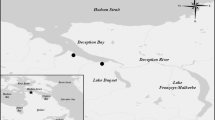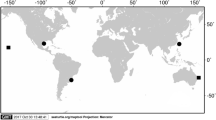Abstract
In this study, we assessed concentrations of 13 trace metals in the scales of Notothenia coriiceps, Trematomus bernacchii and Gobionotothen gibberifrons caught off the coast of James Ross Island (Antarctic Peninsula). Overall, our results for scales broadly match those of previous studies using different fish and different organs, with most metals found at trace levels and manganese, aluminium, iron and zinc occurring at high levels in all species. This suggests that scales can serve as a useful, non-invasive bioindicator of long-term contamination in Antarctic fishes. High accumulation of manganese, aluminium, iron and zinc is largely due to high levels in sediments associated with nearby active volcanic sites. Manganese, vanadium and aluminium showed significant positive bioaccumulation in T. bernacchii (along with non-significant positive accumulation of iron, zinc, cobalt and chromium), most likely due to greater dietary specialisation on sediment feeding benthic prey and higher trophic species. Levels of significance in bioaccumulation regressions were strongly affected by large-scale variation in the data, driven largely by individual differences in diet and/or changes in habitat use and sex differences associated with life stage and reproductive status. Increased levels of both airborne deposition and precipitation and meltwater runoff associated with climate change may be further adding to the already high levels of manganese, aluminium, iron and zinc in Antarctic Peninsula sediments. Further long-term studies are encouraged to elucidate mechanisms of uptake (especially for aluminium and iron) and possible intra- and interspecific impacts of climate change on the delicate Antarctic food web.




Similar content being viewed by others
References
Burger J, Gochfeld M, Kosson D, Powers CW, Friedlander B, Stabin M, Favret D, Jewett S, Snigaroff D, Snigaroff R, Stamm T, Weston J, Jeitner C, Volz C (2007) Radionuclides in marine fishes and birds from Amchitka and Kiska islands in the Aleutians: establishing a baseline. Health Phys 92(3):265–279. https://doi.org/10.1097/01.HP.0000248123.27888.d0
Dórea JG (2008) Persistent, bioaccumulative and toxic substances in fish: human health consideration. Sci Total Environ 400:93–114
Malik N, Biswas AK, Qureshi TA, Borana K, Virha R (2010) Bioaccumulation of heavy metals in fish tissues of a freshwater lake of Bhopal. Environ Monit Assess 160:267–276
Ciesielski T, Pastukhov MV, Szefer P, Jenssen BM (2010) Bioaccumulation of mercury in the pelagic food chain of Lake Baikal. Chemosphere 78:1378–1384
Bargagli R (2000) Trace metals in Antarctica related to climate change and increasing human impact. Rev Environ Cont Toxicol 166:129–173
Sanchez-Hernandez JC (2000) Trace element contamination in Antarctic ecosystems. Rev Environ Cont Toxicol 166:83–127
Beltcheva M, Metcheva R, Peneva V, Marinova M, Yankov Y, Chikova V (2010) Heavy metals in Antarctic Notothenioid fish from South Bay, Livingston Island, South Shetlands (Antarctica). Biol Trace Elem Res 141(1–3):150–158. https://doi.org/10.1007/s12011-010-8739-5
Deheyn DD, Gendreau P, Baldwin RJ, Latz MI (2005) Evidence for enhanced bioavailability of trace metals in the marine ecosystem of Deception Island, a volcano in Antarctica. Mar Environ Res 60:1–33
Bustamante P, Bocher P, Cherel I, Miramand P, Caurant F (2003) Distribution of trace elements in the tissues of benthic and pelagic fish from the Kerguelen Islands. Sci Total Environ 313:25–39. https://doi.org/10.1016/S0048-9697(03)00265-1
McMullin RM, Wing SR, Wing SR, Wing LC, Shatova OA (2017) Trophic position of Antarctic ice fishes reflects food web structure along a gradient in sea ice persistence. Mar Ecol Prog Ser 564:87–98
Murphy EJ, Cavanagh RD, Drinkwater KF, Grant SM, Heymans JJ, Hofmann EE, Hunt GL Jr, Johnston NM (2016) Understanding the structure and functioning of polar pelagic ecosystems to predict the impacts of change. Proc R Soc Lond B 283(1844):20161646. https://doi.org/10.1098/rspb.2016.1646
Eastman JT (2005) The nature of the diversity of Antarctic fishes. Polar Biol 28:94–107
Sures B, Reimann N (2003) Analysis of trace metals in the Antarctic host-parasite system Notothenia coriiceps and Aspersentis megarhynchus (Acanthocephala) caught at King George Island, South Shetland Islands. Polar Biol 26(10):680–686
Jurajda P, Roche K, Sedláček I, Všetičková L (2016) Assemblage characteristics and diet of fish in the shallow coastal waters of James Ross Island. Antarctica Polar Biol 39(12):2299–2309
Reece A (1950) The ice of Crown Prince Gustav Channel, Graham Land, Antarctica. J Glaciol 1:404–409. https://doi.org/10.3189/S0022143000012703
Yoshitomi T, Nakayasu C, Hasegawa S, Iida A, Okamoto N (1998) Site-specific lead distribution in scales of lead-administered carp (Cyprinus carpio) by non-destructive SR-XRF analysis. Chemosphere 36(10):2305–2310
Sultana T, Siddique A, Sultana S, Mahboob S, Al-Ghanim K, Ahmed Z (2017) Fish scales as a non-lethal tool of the toxicity of wastewater from the River Chenab. Environ Sci Poll Res 24(3):2464–2475. https://doi.org/10.1007/s11356-016-7962-9
Valová Z, Jurajda P, Janáč M, Bernardová I, Hudcová H (2010) Spatiotemporal trends of heavy metal concentrations in fish of the River Morava (Danube basin). J Environ Sci Health Part A 45:1892–1899
Červenka R, Bednařík A, Komárek J, Ondračková M, Jurajda P, Vítek T, Vítek T, Spurný P (2011) The relationship between the mercury concentration in fish muscles and scales/fins and its significance. Cent Eur J Chem 9(6):1109–1116
Farrell AP, Hodaly AH, Wang S (2000) Metal analysis of scales taken from arctic grayling. Arch Environ Cont Toxicol 39:515–522
Sauer GR, Watabe N (1989) Temporal and metal-specific patterns in the accumulation of heavy metals by the scales of Fundulus heteroclitus. Aquat Toxicol 14(3):233–248
Márquez M, Vodopivez C, Casaux R, Curtosi A (1998) Metal (Fe, Zn, Mn and Cu) levels in the Antarctic fish Notothenia coriiceps. Polar Biol 20:404–408
Pourang N (1995) Heavy metal bioaccumulation in different tissues of two fish species with regards to their feeding habits and trophic levels. Environ Monit Assoc 35:207–219
Sauer GR, Watabe N (1984) Zinc uptake and its effect on calcification in the scales of the Mummichog. Fundulus heteroclitus Aquat Toxicol 5:51–66
Othman N and Irwan JM (2011) Characterization and optimization of heavy metals biosorption by fish scales. Regional Symposium on Engineering and Technology 2011. 21–23 November 2011. ISBN 978-967-5995-06-4: pp 126–132
Othman N, Abd-Kadir A, Zayadi N (2016) Waste fish scale as cost effective adsorbent in removing zinc and ferum ion in wastewater. ARPN J Eng Appl Sci 11(3):1584–1592
Rosseland BO, Eldhuset TD, Staurnes M (1990) Environmental effects of aluminium. Environ Geochem Health 12(1–2):17–27
Handy RD, Eddy FB (1989) Surface absorption of aluminium by gill tissue and body mucus of rainbow trout, Salmo gairdneri, at the onset of episodic exposure. J Fish Biol 34:865–874
Goutte A, Cherel Y, Churland C, Ponthus J-P, Massé G, Bustamente P (2015) Trace elements in Antarctic fish species and the influence of foraging habitats and dietary habits on mercury levels. Sci Total Environ 538:743–749
Grotti M, Soggia F, Lagomarsino C, Dalla Riva S, Goessler W, Francesconi KA (2008) Natural variability and distribution of trace elements in marine organisms from Antarctic coastal environments. Antarct Sci 20(1):39–51
Honda K, Sahrul M, Hidaka H, Tatsukawa R (1983) Organ and tissue distribution of metals and their growth-related changes in Antarctic fish. Agric Biol Chem 47(11):2521–2532
Barillet S, Adam-Guillermin C, Palluel O, Porcher J-M, Devaux A (2011) Uranium bioaccumulation and biological disorders induced in zebrafish (Danio rerio) after a depleted uranium waterborne exposure. Environ Pollut 159:495–502
Lobel PB, Longerich HP, Jackson SE, Belkhode SP (1991) A major factor contributing to the high degree of unexplained variability of some elements concentrations in biological tissue: 27 elements in 5 organs of the mussel Mytilus as a model. Arch Environ Contam Toxicol 21:118–125
DeWitt HH, Heemstra PS, Gon O (1990) Nototheniidae. In Fishes of the Southern Ocean, Gon 0, Heemstra, PC (eds.), Grahamstown, J.L.B. Smith Institute of Ichthyology. pp 279–331
Kraemer LD, Evans D (2012) Uranium bioaccumulation in a freshwater ecosystem: impact of feeding ecology. Aquat Toxicol:124, 163–125, 170. https://doi.org/10.1016/j.aquatox.2012.08.012
Alìyev SA, Sari A (2003) Biogenic accumulations of uranium in recent seas. Acta Geol Sin 77(3):372–381. https://doi.org/10.1111/j.1755-6724.2003.tb00753.x
Carlig E, Di Blasi D, Ghigliotti L, Pisano E, Faimali M, O’Driscoll R, Parker S, Vacchi M (2018) Diversification of feeding structures in three adult Antarctic nototheniid fish. Polar Biol 41:1–9. https://doi.org/10.1007/s00300-018-2310-9
Mance G and Yates J (1984) Proposed environmental quality standards for list II substances in water - zinc, technical report TR 209, WRc, Medmenham
Tuohy A, Bertler N, Neff P, Edwards R, Emanuelsson D, Beers T, Mayewski P (2015) Transport and deposition of heavy metals in the Ross Sea Region, Antarctica. J Geophys Res D: Atmospheres 120(10):966–11,011. https://doi.org/10.1002/2015JD023293
McConnell JR, Aristarain AJ, Banta JR, Edwards PR, Simões JC (2007) 20th-century doubling in dust archived in an Antarctic Peninsula ice core parallels climate change and desertification in South America. Proc Natl Acad Sci U S A 104:5743–5748
Lowenthal DH, Chow JC, Mazzera DM, Watson JG, Mosher BW. (2000) Aerosol vanadium at McMurdo Station, Antarctica: implications for Dye 3, Greenland Atmos Environ, 34:677–679
Schlesinger WH, Klein EM, Vengosh A (2017) Global biogeochemical cycle of vanadium. Proc Natl Acad Sci U S A 114(52):E11092–E11100. https://doi.org/10.1073/pnas.1715500114
Potocki M, Mayewski PA, Kurbatov AV, Simoes JC, Dixon DA, Goodwin I, Carleton AM, Handley MJ, Jana R, Korotkikh EV (2016) Recent increase in Antarctic Peninsula ice core uranium concentrations. Atmos Environ 140:381–385. https://doi.org/10.1016/j.atmosenv.2016.06.010
Roche K, Kuta J, Sedláček I, Červenka R, Tomanová K, Jurajda P (2018) First data on uranium uptake in three nototheniid fishes from Antarctica (James Ross Island). Chemosphere 211:510–514. https://doi.org/10.1016/j.chemosphere.2018.07.195
Monien D, Monien P, Brunjes R, Widmer T, Kappenberg A, Silva Busso AA, Schnetger B, Brusack H-J (2017) Meltwater as a source of potentially bioavailable iron to Antarctic waters. Antarct Sci 29(3):277–291
Park BK, Chang SK, Yoon HI, Chung H (1998) Recent retreat of the ice cliffs on King George Island, South Shetland Islands, Antarctic Peninsula. Ann Glaciol 27:633–635
Simões JC, Dani N, Bremer UF, Aquino FE, Arigony-Neto J (2004) Small cirque glaciers retreat on Keller Peninsula, Admiralty Bay, King George Island, Antarctica. Pesqui Antárt Brasil 4:49–56 http://repositorio.furg.br/handle/1/5579
Acknowledgements
This study was made possible thanks to financial support from the Grant Agency of the Czech Republic (ECIP Project No. P505/12/G112). We would like to express our thanks for permission to use the J.G. Mendel Czech Antarctic Station on James Ross Island in 2014 and all our expedition colleagues for their technical help while stationed there. Research activities at the J.G. Mendel Station are carried out as part of the Czech Polar Research Infrastructure (project no. LM2015078) and RECETOX Research Infrastructure (project no. LM2015051), financed through the Ministry of Education, Youth and Sports of the Czech Republic and European Structural and Investment Funds, Operational Programme for Research, Development and Education (CZ.02.1.01/0.0/0.0/16_013/0001761). Thanks also go to Michal Janač for help and advice with statistical issues.
Author information
Authors and Affiliations
Corresponding author
Ethics declarations
Members of the 8th Czech Antarctic expedition were authorised to work and collect samples under Section 8 of Czech Act No. 276/2003 Coll. Collection of samples adhered to all Czech legal requirements regarding animal handling and welfare, and was approved by the Ethical Committee of the Institute of Vertebrate Biology of the Czech Academy of Sciences.
Conflict of Interest
The authors declare that they have no conflicts of interest.
Additional information
Publisher’s Note
Springer Nature remains neutral with regard to jurisdictional claims in published maps and institutional affiliations.
Electronic supplementary material
Supplementary Table 1
Operating conditions for the Agilent 7700x inductively coupled plasma mass spectrometer (IPC-MS). (DOCX 20 kb)
Supplementary Table 2
NIST SRM 1486 Bone Meal certified values and recovery values for spiked samples (median [three replicates] and standard deviation). (DOCX 15.0 kb)
Rights and permissions
About this article
Cite this article
Roche, K., Kuta, J., Sedláček, I. et al. Concentrations of Thirteen Trace Metals in Scales of Three Nototheniid Fishes from Antarctica (James Ross Island, Antarctic Peninsula). Biol Trace Elem Res 191, 214–223 (2019). https://doi.org/10.1007/s12011-018-1598-1
Received:
Accepted:
Published:
Issue Date:
DOI: https://doi.org/10.1007/s12011-018-1598-1




